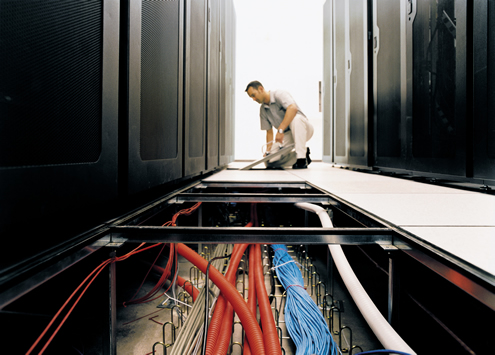The Inside Dirt on Raised Floors
Raised floors, as the name suggests, are elevated, hollow platforms that are built on top of the regular concrete floor. They are used to provide passage for electrical and mechanical services. This is mostly done to avoid littering the floor with wires and cables that are essential in a data center but you would rather not have your staff tripping over.
 The height of the raised floor can vary from 2 inches to 4 inches from the concrete floor depending on the data center’s requirements and the height of the room above the raised floors. It is mandatory that the ceiling is at least 9 feet from the floor. One of the most popular uses of raised floor is cooling. One can get perforated tiles through which air from the CRAC can be directed and supplied to cool the room.
The height of the raised floor can vary from 2 inches to 4 inches from the concrete floor depending on the data center’s requirements and the height of the room above the raised floors. It is mandatory that the ceiling is at least 9 feet from the floor. One of the most popular uses of raised floor is cooling. One can get perforated tiles through which air from the CRAC can be directed and supplied to cool the room.
Drawbacks of Raised Floors
But this technology is outdated. Data centers have come to a conclusion that they can do away with raised floors and their operation efficiency still remains the same. Technology is not the same as it was a decade ago. With the arrival blade servers and high-density server racks, the power cables have got thicker. Raised floors have ceased to be very useful in this regard. There is a limitation to the number of cables that you can place without heating the space beneath the raised floors.
Installation of raised floors is expensive. Under-floor maintenance also adds to the expense. Fire sensors, lighting also add to the overhead costs. Also, as the high density servers are becoming more compact, more servers can be fit into the same rack. As a result, the racks have started to weigh a ton; most raised floors will not be able to withstand the weight. The raised floors can even collapse under the increased weight.
Alternative Solutions
Cooling is no longer a big issue. Data centers are now opting for row level cooling or localised cooling. By adopting airflow management techniques like hot aisle and cold aisle, localised heating can be resolved more effectively than raised floors. They also reduce the PUE of the data center and bring down the annual electricity costs.
As mentioned before, it is not advisable to have cables running all over the floor. If we eliminate raised floors, there has to be some way to deal with the cable layout. False ceiling or overhead cable management, as a solution to this problem, is gaining popularity. They provide lesser cooling disruption and fault location is relatively easier. But accessibility is, once again, a concern.
But…
Having said all that, raised floors are not going to be thrown out to the curb any time soon. The change is gradual; everybody is exploring alternative ways to reduce PUE and improve efficiency. In some data centers, raised floors act as the most effective and economic solution to cooling and cable management. In such cases, the idea of adopting it can’t be discarded just because it is old fashioned.
Data Center Talk updates its resources everyday. Visit us to know of the latest technology and standards from the data center world.
Please leave your views and comments on DCT Forum.
